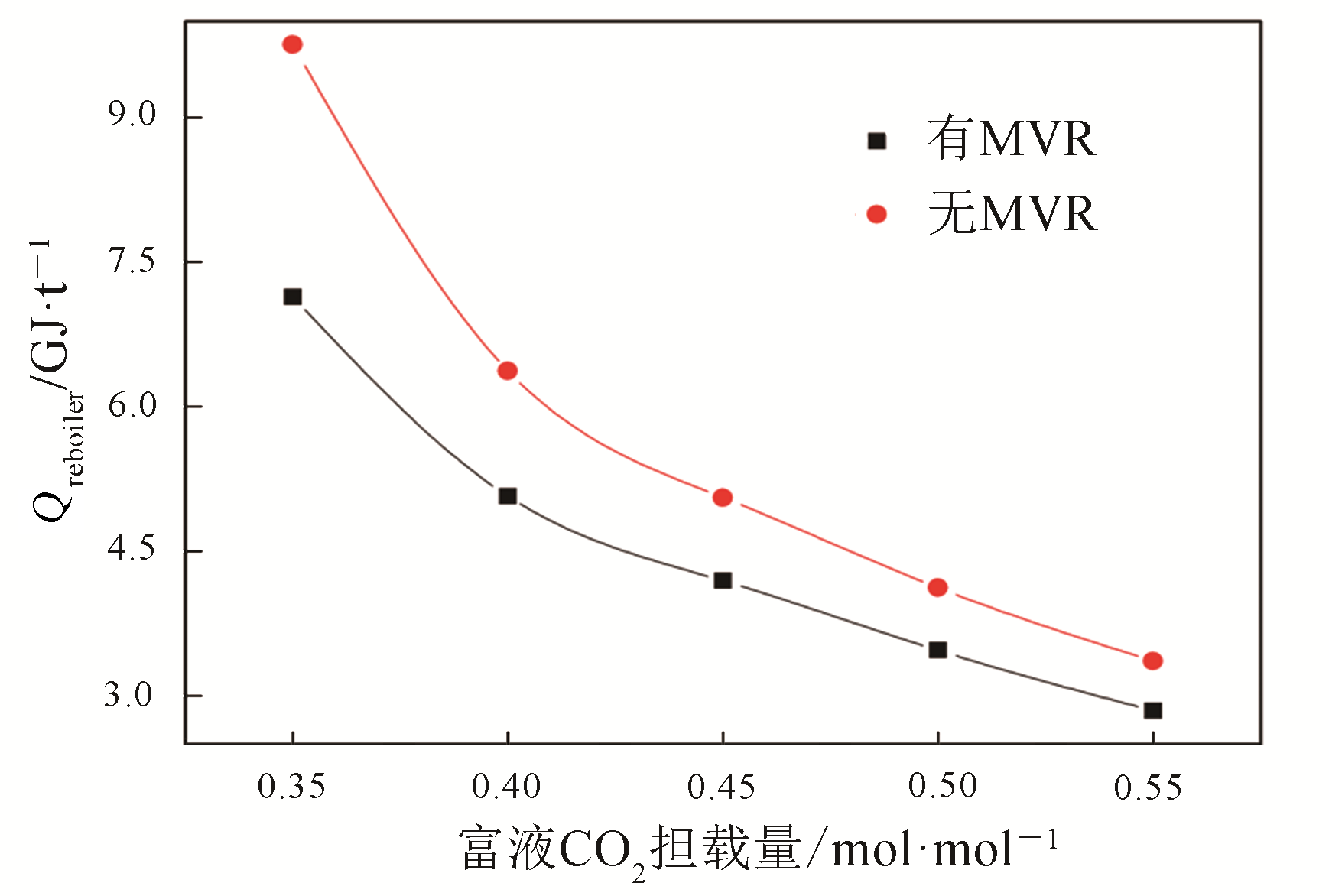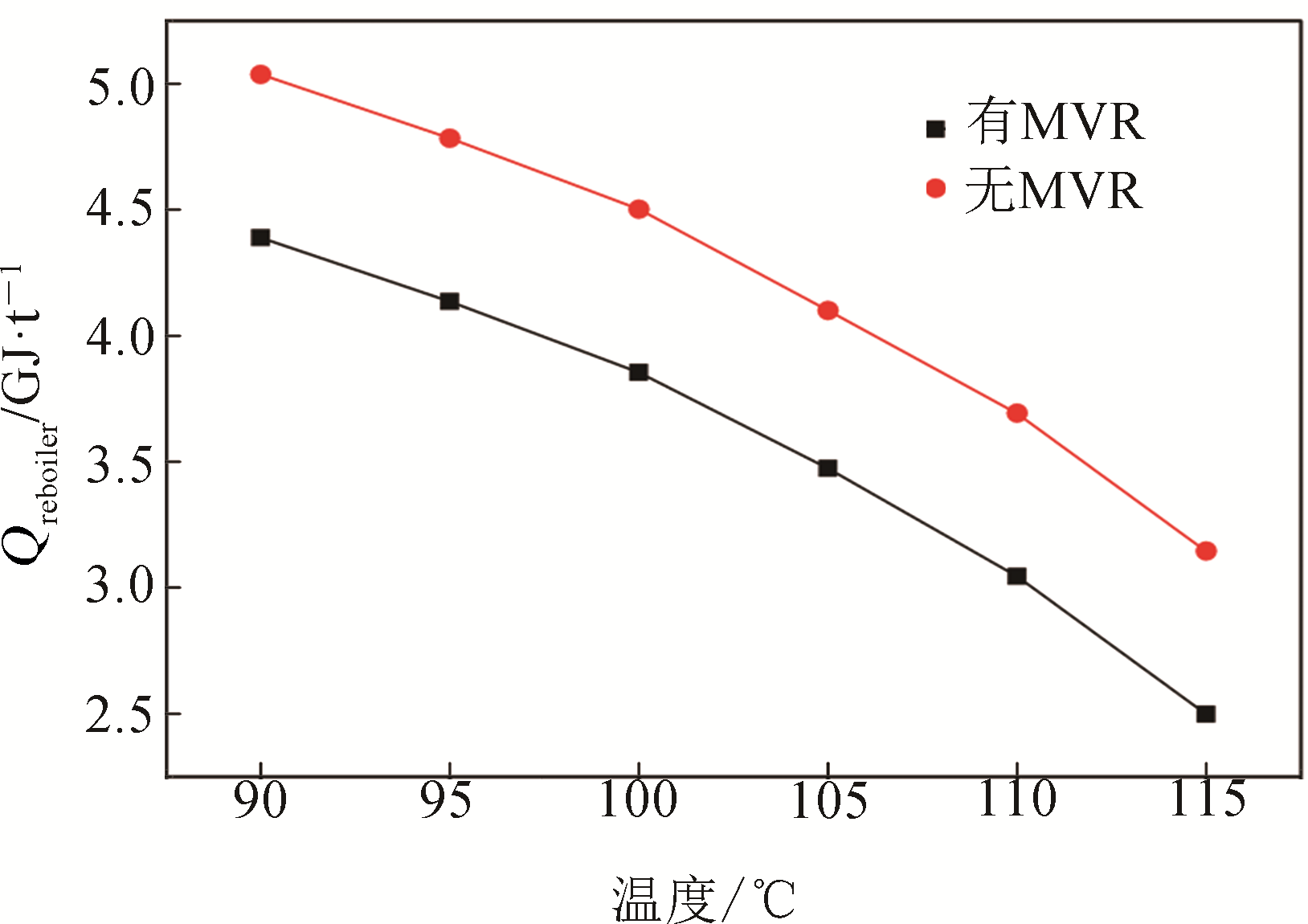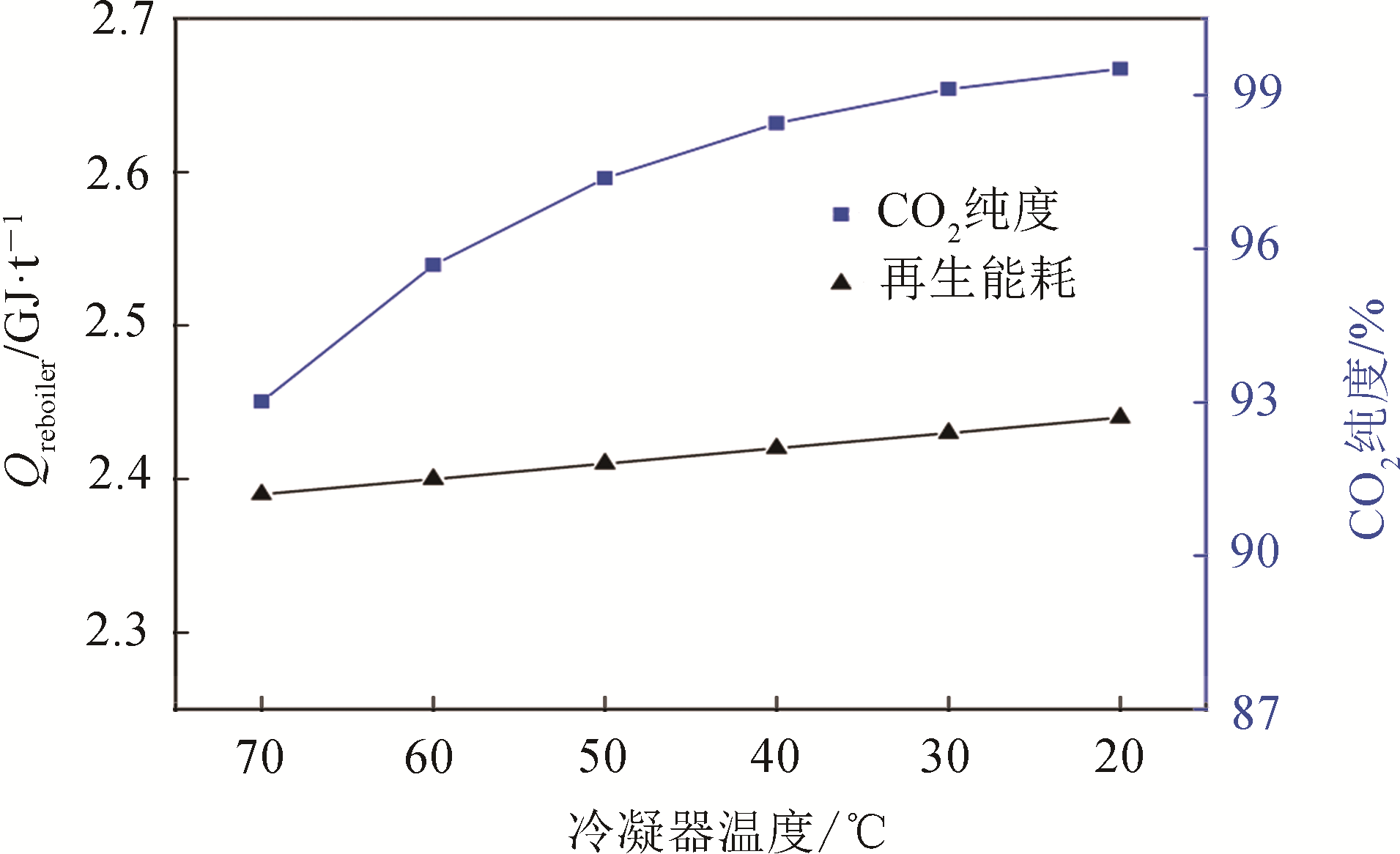Chemical Industry and Engineering Progress ›› 2020, Vol. 39 ›› Issue (S1): 256-262.DOI: 10.16085/j.issn.1000-6613.2019-1417
• Resources and environmental engineering • Previous Articles Next Articles
Key parameters and energy consumption analysis of amine decarburization regeneration system with MVR for coal-fired flue gas
- National Energy Investment Group Co. , Ltd. , Beijing 100011, China
-
Received:2019-09-06Online:2020-06-29Published:2020-05-20 -
Contact:Shumin WANG
燃煤烟气胺法脱碳MVR再生系统关键参数及能耗分析
- 国家能源投资集团有限责任公司,北京 100011
-
通讯作者:王树民 -
作者简介:赵红涛(1985—),男,工程师,研究方向为燃煤电厂CO2减排与煤炭清洁转化。E-mail:zhaohongtaoipe@163.com 。 -
基金资助:国家重点研发计划(2017YFB0603300)
CLC Number:
Cite this article
Hongtao ZHAO, Shumin WANG. Key parameters and energy consumption analysis of amine decarburization regeneration system with MVR for coal-fired flue gas[J]. Chemical Industry and Engineering Progress, 2020, 39(S1): 256-262.
赵红涛, 王树民. 燃煤烟气胺法脱碳MVR再生系统关键参数及能耗分析[J]. 化工进展, 2020, 39(S1): 256-262.
share this article
Add to citation manager EndNote|Ris|BibTeX
URL: https://hgjz.cip.com.cn/EN/10.16085/j.issn.1000-6613.2019-1417
| N2 | O2 | CO2 | H2O | SO2 | NOx | 烟尘 | 温度 | 表压 |
|---|---|---|---|---|---|---|---|---|
| 70.7% | 6.1% | 11.1% | 12.1% | 35mg·m-3 | 50mg·m-3 | <10mg·m-3 | 40~50℃ | -0.14kPa |
| N2 | O2 | CO2 | H2O | SO2 | NOx | 烟尘 | 温度 | 表压 |
|---|---|---|---|---|---|---|---|---|
| 70.7% | 6.1% | 11.1% | 12.1% | 35mg·m-3 | 50mg·m-3 | <10mg·m-3 | 40~50℃ | -0.14kPa |
| 序号 | 类型 | 反应方程式 |
|---|---|---|
| 1 | equilibrium | |
| 2 | equilibrium | |
| 3 | equilibrium | |
| 4 | kinetic | |
| 5 | kinetic | |
| 6 | kinetic | |
| 7 | kinetic |
| 序号 | 类型 | 反应方程式 |
|---|---|---|
| 1 | equilibrium | |
| 2 | equilibrium | |
| 3 | equilibrium | |
| 4 | kinetic | |
| 5 | kinetic | |
| 6 | kinetic | |
| 7 | kinetic |
| 序号 | 设备名称 | 单元模型 | 操作条件 |
|---|---|---|---|
| 1 | 换热器 | Heater | 90~115℃ |
| 2 | 再生塔 | RadFrac | 理论塔板20层 操作压力1.6~4.0atm 填料Mellapak 250Y |
| 3 | 闪蒸罐 | Flash2 | 0.8~1.7atm,绝热 |
| 4 | 压缩机 | Compr | 操作压力1.6~4.0atm 等熵效率1.0 |
| 序号 | 设备名称 | 单元模型 | 操作条件 |
|---|---|---|---|
| 1 | 换热器 | Heater | 90~115℃ |
| 2 | 再生塔 | RadFrac | 理论塔板20层 操作压力1.6~4.0atm 填料Mellapak 250Y |
| 3 | 闪蒸罐 | Flash2 | 0.8~1.7atm,绝热 |
| 4 | 压缩机 | Compr | 操作压力1.6~4.0atm 等熵效率1.0 |
| 1 | HEMMATI A, RASHIDI H. Optimization of industrial intercooled post-combustion CO2 absorber by applying rate-base model and response surface methodology (RSM)[J]. Process Safety and Environmental Protection, 2019, 121: 77-86. |
| 2 | BAO W, ZHAO H, LI H, et al. Process simulation of mineral carbonation of phosphogypsum with ammonia under increased CO2 pressure[J]. Journal of CO2 Utilization, 2017, 17: 125-136. |
| 3 | ROLFE A, HUANG Y, HAAF M, et al. Integration of the calcium carbonate looping process into an existing pulverized coal-fired power plant for CO2 capture: techno-economic and environmental evaluation[J]. Applied Energy, 2018, 222: 169-179. |
| 4 | 何卉, 方梦祥, 王涛, 等. 燃煤烟气化学吸收碳捕集系统分析与优化[J]. 化工进展, 2018, 37(6): 2406-2412. |
| HE H, FANG M X, WANG T, et al. Analysis and optimization of post-combustion CO2 capture system based on chemical absorption[J]. Chemical Industry and Engineering Progress, 2018, 37(6): 2406-2412. | |
| 5 | WANG S, YAN S, MA X, et al. Recent advances in capture of carbon dioxide using alkali-metal-based oxides[J]. Energy & Environmental Science, 2011, 4(10): 3805-3819. |
| 6 | 李小飞, 王淑娟, 陈昌和. 胺法脱碳系统再生能耗[J]. 化工学报, 2013, 64(9): 3348-3355. |
| LI X F, WANG S J, CHEN C H. Heat requirement for regeneration of a CO2 capture system using amine solutions[J]. CIESC Journal, 2013, 64(9): 3348-3355. | |
| 7 | 陆诗建, 高丽娟, 陆胤君, 等. 胺法捕集烟气中CO2热能综合利用研究[J]. 计算机与应用化学, 2018, 35(10): 843-854. |
| LU S J, GAO L J, LU Y J, et al. Comprehensive utilization of heat energy in CO2 capture process by MEA method[J]. Computers and Applied Chemistry, 2018, 35(10): 843-854. | |
| 8 | SI Z, HAN D, SONG Y, et al. Experimental investigation on a combined system of vacuum membrane distillation and mechanical vapor recompression[J]. Chemical Engineering and Processing: Process Intensification, 2019, 139: 172-182. |
| 9 | YANG J, ZHANG C, ZHANG Z, et al. Electroplating wastewater concentration system utilizing mechanical vapor recompression[J]. Journal of Environmental Engineering, 2018, 144(7): 04018053. |
| 10 | 董文虎, 孙玉堂, 陈光强, 等. MVR蒸发系统在淡盐水浓缩中的应用[J]. 氯碱工业, 2017, 53(1): 37-39. |
| DONG W H, SUN Y T, CHEN G Q, et al. Application of MVR evaporation system in concentration of depleted brine[J]. Chlor-Alkali Industry, 2017, 53(1): 37-39. | |
| 11 | 越云凯, 吴小华, 张振涛. MVR海水淡化系统运行特性分析与优化[J]. 工程热物理学报, 2018(9): 16. |
| YUE Y K, WU X H, ZHANG Z T. Operation characteristic analysis and optimization MVR seawaterer desaliation system[J]. Journal of Engineering Thermophysics, 2018(9): 16. | |
| 12 | 杨德明, 印一凡, 王争光, 等. 蒸发耦合精馏处理含盐甲醇废水的MVR节能工艺[J]. 化学工程, 2019(8): 16. |
| YANG D M, YIN Y F, WANG Z G, et al. MVR energy-saving technology for treatment of methanol wastewater containing salt based on evaporation coupling distillation[J]. Chemical Engineering (China), 2019(8): 16. | |
| 13 | 王帅, 张军. 机械蒸发再压缩(MVR)技术进展研究[J]. 节能, 2017, 36(11): 4-6. |
| WANG S, ZHANG J. Research progress of mechanical vapor recompression (MVR) technology[J]. Energy Conservation, 2017, 36(11): 4-6. | |
| 14 | NAYAR K G, FERNANDES J, MCGOVERN R K, et al. Cost and energy needs of RO-ED-crystallizer systems for zero brine discharge seawater desalination[J]. Desalination, 2019, 457: 115-132. |
| 15 | LU S J, ZHAO D Y, ZHU Q M. CO2 absorber coupled with double pump CO2 capture technology for coal-fired flue gas[J]. Energy Procedia, 2018, 154: 163-170. |
| 16 | VOU-HARBOU I, IMLE M, HASSE H. Modeling and simulation of reactive absorption of CO2 with MEA: results for four different packings on two different scales[J]. Chemical Engineering Science, 2014, 105: 179-190. |
| 17 | FLØ N E, FARAMARZI L, IVERSEN F, et al. Assessment of material selection for the CO2 absorption process with aqueous MEA solution based on results from corrosion monitoring at Technology Centre Mongstad[J]. International Journal of Greenhouse Gas Control, 2019, 84: 91-110. |
| 18 | WANG T, HE H, YU W, et al. Process simulations of CO2 desorption in the interaction between the novel direct steam stripping process and solvents[J]. Energy & Fuels, 2017, 31(4): 4255-4262. |
| 19 | ZHANG M K, GUO Y C. Performance simulations of MEA and NH3 basedlarge-scale CO2 capture in packed columns under different flue gas parameters[J]. Korean Journal of Chemical Engineering, 2015, 32(8): 1477-1485. |
| 20 | SHARIFZADEH M, SHAH N. MEA-based CO2 capture integrated with natural gas combined cycle or pulverized coal power plants: operability and controllability through integrated design and control[J]. Journal of Cleaner Production, 2019, 207: 271-283. |
| 21 | LIU J. Investigation of energy-saving designs for an aqueous ammonia-based carbon capture process[J]. Industrial & Engineering Chemistry Research, 2018, 57(45): 15460-15472. |
| 22 | 何卉. 二氧化碳化学吸收系统的工艺流程改进和集成优化研究[D]. 杭州: 浙江大学, 2018. |
| HE H. Study on the modification and integration of CO2 chemical absorption process [D]. Hangzhou: Zhejiang University, 2018. | |
| 23 | GALINDO P, SCHAFFER A, BRECHTEL K, et al. Experimental research on the performance of CO2-loaded solutions of MEA and DEA at regeneration conditions[J]. Fuel, 2012, 101: 2-8. |
| 24 | 陆诗建, 高丽娟, 王家凤, 等. 烟气CO2捕集热能梯级利用节能工艺耦合优化[J]. 化工进展, 2019, 38(2): 728-737. |
| LU S J, GAO L J, WANG J F, et al. Coupling optimization of energy-saving technology for cascade utilization of flue gas CO2 capture system[J]. Chemical Industry and Engineering Progress, 2019, 38(2): 728-737. | |
| 25 | 涂巍巍, 方佳伟, 李竹石, 等. 基于MEA的CO2相变化吸收剂的开发[J]. 中国科学: 化学, 2018, 48(6): 641-647. |
| TU W W, FANG J W, LI Z S, et al. Development of MEA phase change absorbent[J]. Scientia Sinica (Chimica), 2018, 48(6): 641-647. | |
| 26 | HONG H, LI W, GU C. Performance study on a mechanical vapor compression evaporation system driven by Roots compressor[J]. International Journal of Heat and Mass Transfer, 2018, 125: 343-349. |
| [1] | ZHENG Qian, GUAN Xiushuai, JIN Shanbiao, ZHANG Changming, ZHANG Xiaochao. Photothermal catalysis synthesis of DMC from CO2 and methanol over Ce0.25Zr0.75O2 solid solution [J]. Chemical Industry and Engineering Progress, 2023, 42(S1): 319-327. |
| [2] | SUN Yuyu, CAI Xinlei, TANG Jihai, HUANG Jingjing, HUANG Yiping, LIU Jie. Optimization and energy-saving of a reactive distillation process for the synthesis of methyl methacrylate [J]. Chemical Industry and Engineering Progress, 2023, 42(S1): 56-63. |
| [3] | YANG Hanyue, KONG Lingzhen, CHEN Jiaqing, SUN Huan, SONG Jiakai, WANG Sicheng, KONG Biao. Decarbonization performance of downflow tubular gas-liquid contactor of microbubble-type [J]. Chemical Industry and Engineering Progress, 2023, 42(S1): 197-204. |
| [4] | WANG Yaogang, HAN Zishan, GAO Jiachen, WANG Xinyu, LI Siqi, YANG Quanhong, WENG Zhe. Strategies for regulating product selectivity of copper-based catalysts in electrochemical CO2 reduction [J]. Chemical Industry and Engineering Progress, 2023, 42(8): 4043-4057. |
| [5] | LIU Yi, FANG Qiang, ZHONG Dazhong, ZHAO Qiang, LI Jinping. Cu facets regulation of Ag/Cu coupled catalysts for electrocatalytic reduction of carbon dioxide [J]. Chemical Industry and Engineering Progress, 2023, 42(8): 4136-4142. |
| [6] | HUANG Yufei, LI Ziyi, HUANG Yangqiang, JIN Bo, LUO Xiao, LIANG Zhiwu. Research progress on catalysts for photocatalytic CO2 and CH4 reforming [J]. Chemical Industry and Engineering Progress, 2023, 42(8): 4247-4263. |
| [7] | LOU Baohui, WU Xianhao, ZHANG Chi, CHEN Zhen, FENG Xiangdong. Advances in nanofluid for CO2 absorption and separation [J]. Chemical Industry and Engineering Progress, 2023, 42(7): 3802-3815. |
| [8] | LYU Chao, ZHANG Xiwen, JIN Lijian, YANG Linjun. Efficient capture of CO2 by a new biphasic solvent-ionic liquid system [J]. Chemical Industry and Engineering Progress, 2023, 42(6): 3226-3232. |
| [9] | WANG Keju, ZHAO Cheng, HU Xiaomei, YUN Junge, WEI Ninghan, JIANG Xueying, ZOU Yun, CHEN Zhihang. Research progress of low temperature catalytic oxidation of VOCs by metal oxides [J]. Chemical Industry and Engineering Progress, 2023, 42(5): 2402-2412. |
| [10] | MA Yuan, XIAO Qingyue, YUE Junrong, CUI Yanbin, LIU Jiao, XU Guangwen. CO xco-methanation over a Ni-based catalyst supported on CeO2-Al2O3 composite [J]. Chemical Industry and Engineering Progress, 2023, 42(5): 2421-2428. |
| [11] | HE Zhiyong, GUO Tianfo, WANG Jinli, LYU Feng. Progress of CO2/epoxide copolymerization catalyst [J]. Chemical Industry and Engineering Progress, 2023, 42(4): 1847-1859. |
| [12] | FU Le, YANG Yang, XU Wenqing, GENG Zanbu, ZHU Tingyu, HAO Runlong. Research progress in CO2 capture technology using novel biphasic organic amine absorbent [J]. Chemical Industry and Engineering Progress, 2023, 42(4): 2068-2080. |
| [13] | CHEN Chongming, ZENG Siming, LUO Xiaona, SONG Guosheng, HAN Zhongge, YU Jinxing, SUN Nannan. Preparation and performance of carbon supported potassium-based CO2 adsorbent derived from hyper-cross linked polymers [J]. Chemical Industry and Engineering Progress, 2023, 42(3): 1540-1550. |
| [14] | WANG Qiuhua, WU Jiashuai, ZHANG Weifeng. Research progress of alkaline industrial solid wastes mineralization for carbon dioxide sequestration [J]. Chemical Industry and Engineering Progress, 2023, 42(3): 1572-1582. |
| [15] | WANG Xiaoyue, ZHANG Weimin, YAO Zhengyang, GUO Xiaohong, LI Congming. Research progress of reverse water gas shift reaction [J]. Chemical Industry and Engineering Progress, 2023, 42(3): 1583-1594. |
| Viewed | ||||||
|
Full text |
|
|||||
|
Abstract |
|
|||||






